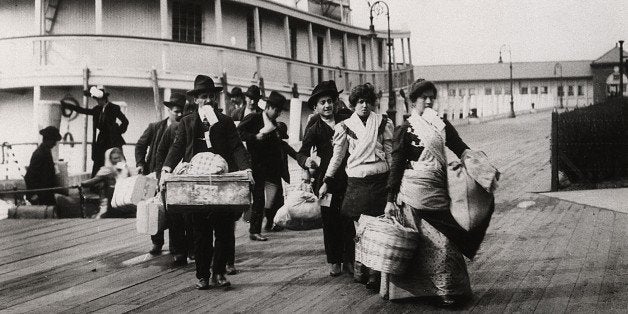
This is Part 2 of a two -part brief history of education in the United States from the Puritans to Race to the Top. One thing that stands out is that education is never either an independent force in American society or a principle agent for social change. It is a reflection of the basic debates talking place in the broader society. In each of these periods highlighted in the two-part series education was also about mechanisms for social control in a society undergoing cultural and demographic change. In the 1950s expanded educational funding and opportunity was part of the Cold War. Today educational "reform" is a major part of both the debate over how the United States should respond to globalization, computerization, and deindustrialization and also again over what to do about a new wave of both documented and undocumented immigrants.
From the Civil War to Race to the Top
In the post-Civil War era the federal government established boarding schools under the auspices of the Army for the forced assimilation of Native American children. Richard Pratt, an army officer who founded the first of these schools described his philosophy in a speech in 1892. "A great general has said that the only good Indian is a dead one. In a sense, I agree with the sentiment, but only in this: that all the Indian there is in the race should be dead. Kill the Indian in him, and save the man."
The ideology and policies directed at Native Americans were later used to justify efforts to rapidly assimilate Southern and Eastern European immigrants and their American-born children during and after World War I. As part of an Americanization movement more than thirty states passed laws mandating programs that required classes for adults in English language and American civics and after-school and Saturday classes for immigrant youth. The 1906 Nationality Act made the ability to speak English a requirement for naturalization, and the 1917 Immigration Act excluded illiterates from entering the United States. A Committee for Immigrants in America helped fund the Division of Immigrant Education in the federal Bureau of Education. After World War I, the emphasis of Americanization programs shifted from emergency measures to a long-term educational effort primarily based in public schools. The focus on forced assimilation and its failures also morphed in the 1920s into anti-immigrant, anti-radical, and nativist campaigns that led to harsh immigration restriction laws in 1921 and 1924.
Post-World War II
Since World War II education in the United States has been affected by a number of conflicting forces. The African American Civil Rights Movement of the 1950s and 1960s protested against the inequities of racial segregation and challenged it in the courts. In 1954, the Supreme Court in Brown v. Board of Education unanimously declared that de jure separate educational facilities were inherently unequal and unconstitutional. In response Southern officials delayed implementing the decision and many White southerners transferred their children to racially segregated private schools. Northern and urban schools grew increasingly segregated during this period as Blacks moved into northern cities and Whites took advantage of federal programs to assist returning veterans to move to new suburban communities.
During the post-war period federal involvement in education expanded significantly, first as part of Cold War defense initiatives following the Soviet Union's launch of Sputnik and then as part of the Johnson administration's Great Society initiative. In 1965 the Elementary and Secondary Education Act increased federal financial support for local school districts. In 1983, a report by the National Commission on Excellence in Education, A Nation at Risk, demanded greater state and federal attention to improving education in the United States. It lead to eventual bipartisan support for the 2002 No Child Left Behind act which offered states increased federal aid in return for measuring student performance on standardized exams in math and language arts and reorganizing or closing failing schools. In 2009, Race to the Top offered states federal grants if they adopted more stringent exams aligned with newly disseminated Common Core Standards.
Post-World War II and 21st century factors shaping education in the United States include:
•The Civil Rights movement, demands for racially integrated schools, the Brown decision (1954), White backlash, the formation of segregated White private schools, White flight to new racially and economically segregated suburban communities, and school funding based on locality.
•Unionization and professionalization of teaching with an increase in teacher salaries, benefits, and pensions as a cost of providing public education.
•Changes in the work force including waves of educated women workers, a shift to white-collar work, and new demands for technological competence.
•Globalization and the outsourcing first of blue-collar factory work and later of many white-collar jobs to low paying countries.
•Changing demographics as a result of increased documented and undocumented immigration and lower birth rates for White or Anglo-Americans mean a majority of students in public schools are no longer of European ancestry.
•Zero tolerance disciplinary practices in schools leading to a wave of student suspensions feeding teenagers, especially African American and Latino males, into the criminal justice system.
•A continually increasing federal role in shaping education policy including No Child Left Behind (2001), Race to the Top (2009), and Common Core (2009).
•Demands for charters and private school vouchers by opponents of public education and attacks on teacher unions.
•Calls for the increased integration of computers and new instructional technology into the classroom with implications for the deprofessionalization of teachers and their replacement by computer programs.
•The emergence of hedge funds, technology and testing companies, lobbying for the privatization of education or of specific educational services.
•High-stakes testing and data tracking of student and teacher performance followed by growing resistance from both teacher organizations and parent groups.
